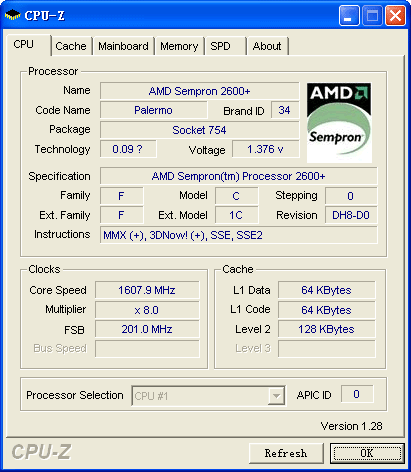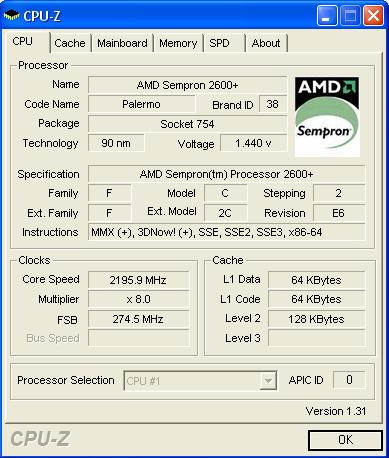AMD K8 Overclocking Guide |
|
Introduction
Overclocking, the practice of pushing your hardware to the limits is a widely practiced ritual by computer enthusiasts for as long as it has been possible to. Today, you can overclock the CPU, RAM and video card with ease. But if you don’t know what you’re doing, you can damage your precious hardware permanently. This guide's purpose is to get you familiar with overclocking on the AMD K8 platform, its basics, and even some advanced topics.The AMD K8 Series
The AMD K8 series is well known for its overclocking capabilities. The K8 series includes all Socket 754 and 939 CPUs. There are many factors that make a CPU a good overclocker.First we have the core. The core is the technology codename of your CPU. There are numerous cores for the K8 series. For Socket 754 we have Clawhammer and Newcastle for the Athlon 64, and the Paris and Palermo for Semprons. For Socket 939, we have the Clawhammer, Newcastle, Winchester, Venice, San Diego, Manchester and Toledo. This may seem like many, but there are very few differences between the cores.
Some are major, while others are less so. The difference between Sockets 754 and 939 is dual channel memory support. In real world applications the difference is about 4-6%, but you should always get the newest platform, in this case, Socket 939.
One major difference between cores is the process size and heat output. The process is measured in nanometers. The K8 series comes in 130nm and 90nm CPU flavors. The major differences are heat output and overclocking potential. The 130nm cores didn’t overclock much, with an average max of about 2.5-2.6GHz using air/water cooling. They also put out significantly more heat. The 90nm cores can reach up to 3.0GHz with low voltages on air/water. The 90nm cores also default at 0.1V less, taking up to 10 degrees Celsius off of the maximum temperature. 130nm cores are no longer produced for the Socket 939 platform, so you don’t have to worry too much.
There is no current reason to buy a Socket 754 platform unless you buy a budget Sempron, which are all 90nm. Overclocking is not guaranteed. Some CPUs overclock great, while the next one of the same model, doesn’t overclock at all. These are extremes, so in general, most CPUs of the same Core overclock to the same maxes.
Let’s examine the differences between the current cores. They are all 90nm. A complete list of all modern CPUs together with their specs can be found in our CPU Database.
| Core | Socket | L2 Cache | Single/Dual Core |
|---|---|---|---|
| Palermo | 754 | 128kb-256kb | Single |
| Venice | 939 | 512kb | Single |
| San Diego | 939 | 1024kb | Single |
| Manchester | 939 | 512kb x2 | Dual |
| Toledo | 939 | 1024kb x2 | Dual |
As you can see, the 939 CPU cores can be paired together. They only differ in cache size.
It's All About Numbers

Now let’s get into the speed numbers behind the K8 series. Let’s use my Sempron 2600+ as an example.
Its stock speed is 1600MHz. How do they get this frequency? There are two factors that multiply to form 1600MHz. The first is the Frontside Bus (FSB). This is 200MHz for all K8 CPUs, regardless of the core. The second is the CPU Multiplier. For this CPU it is a maximum of 8x. This results in 200MHz x 8=1600MHz. for a 2000MHz CPU, the multiplier would be 10x. The multiplier can not be raised, only lowered. The CPU Multiplier on the K8 series CPUs can be lowered to 4x (though there is no need for that). The only exceptions to this rule are the FX series. Their multipliers are “unlocked” and can be changed in both directions. However things get a bit more complicated.
There is also a HyperTransport (HT) speed. This is calculated by multiplying the FSB by the HT multiplier. The HT Multiplier is a maximum of 5x for Socket 939 CPUs, and 4x for 754 CPUs. So the default HT Frequency for 939 CPUs is 1GHz, and for 754 CPUs it is 800MHz. The significance of this I’ll discuss later. Unfortunately this gets even more complicated. The next part to get involved in this overclocking mess is the RAM. By default, the RAM speed is in sync (parallel) with the FSB. PC3200 or DDR400 memory is the default memory speed rating for the K8 series. This same memory runs at 200MHz (400MHz effective). This is the in sync, 1:1 ratio.

May 6th, 2024 16:33 EDT
change timezone
Latest GPU Drivers
New Forum Posts
- HELP-pc turns on then off instantly (11)
- Is this Sapphire PULSE RX 5600 XT legit or fake? (42)
- GPU Hot Spot Temperature 105 Celsius, fans at 3000 RPM, while GPU Temperature is max 70 Celsius (37)
- 7900 XTX Seriously lacking (117)
- Only some humans can see refresh rates faster than others, I am one of those humans. (181)
- nvflashk - Flash any BIOS to NVIDIA GPUs - Safe board ID bypass up to 4xxx series (239)
- Envinda RX 580 2048SP 8GB no image (20)
- AAF Optimus DCH Audio Modded Driver for Windows 10/11 - For ALL HDAUDIO Enumerator Chips (658)
- Update on the whole PC rebooting issue. There was an extra standoff in the case, but now it's crashing even more (0)
- What is this? (5)
Popular Reviews
- Finalmouse UltralightX Review
- ASRock NUC BOX-155H (Intel Core Ultra 7 155H) Review
- Meze Audio LIRIC 2nd Generation Closed-Back Headphones Review
- Cougar Hotrod Royal Gaming Chair Review
- Upcoming Hardware Launches 2023 (Updated Feb 2024)
- AMD Ryzen 7 7800X3D Review - The Best Gaming CPU
- Montech Sky Two GX Review
- ASUS Radeon RX 7900 GRE TUF OC Review
- HYTE THICC Q60 240 mm AIO Review
- Logitech G Pro X Superlight 2 Review - Updated with 4000 Hz Tested
Controversial News Posts
- Intel Statement on Stability Issues: "Motherboard Makers to Blame" (248)
- Windows 11 Now Officially Adware as Microsoft Embeds Ads in the Start Menu (167)
- AMD to Redesign Ray Tracing Hardware on RDNA 4 (165)
- Sony PlayStation 5 Pro Specifications Confirmed, Console Arrives Before Holidays (117)
- AMD's RDNA 4 GPUs Could Stick with 18 Gbps GDDR6 Memory (114)
- NVIDIA Points Intel Raptor Lake CPU Users to Get Help from Intel Amid System Instability Issues (106)
- AMD Ryzen 9 7900X3D Now at a Mouth-watering $329 (104)
- AMD "Strix Halo" Zen 5 Mobile Processor Pictured: Chiplet-based, Uses 256-bit LPDDR5X (103)